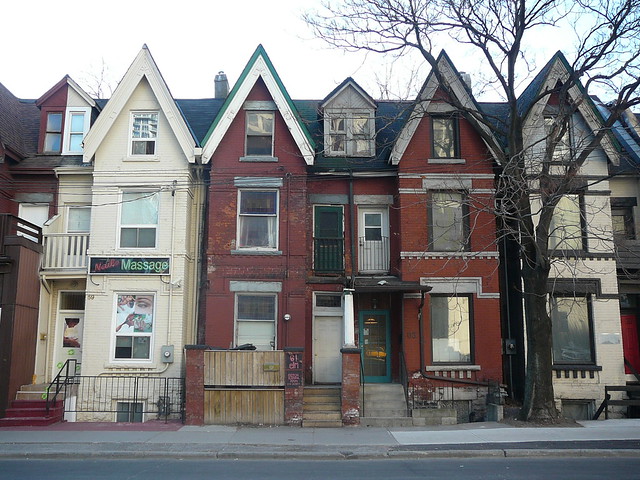Housing is becoming increasingly unaffordable in big cities around the world, and Toronto is no exception. In this excerpt from the newly published anthology House Divided: How the Missing Middle Will Solve Toronto’s Affordability Crisis, John Clapp details his recent experience of homelessness and the four catch-22s that make it nearly impossible to find affordable housing in the country’s most expensive city.
What follows are my experiences as a low-income and recently homeless Torontonian struggling to secure and maintain stable and affordable housing.
To that end, I’ll be mostly critical of the policies of the following agencies and programs: Toronto Employment and Social Services (TESS), which administers the Transitional Housing Assistance Program and the Housing Stabilization Fund (HSF); Ontario Works/Ontario Disability Support Program, which provides a maximum accommodation allowance of $495 per month; the Personal Needs Allowance, a former OW-related program that provided $27 per week to shelter clients; and the Community Start-Up Program (C-SUP), a former housing support program administered directly by OW/ODSP.
Before becoming homeless in June 2018, I rented sublet accommodations for about a decade and always paid my rent on time. As most rooms for rent are sublets, and as that was all I could afford, I had little choice but to rent as a sub-tenant. As a result, I’ve had virtually no tenant rights.
However, my lack of tenant rights did not prove to be the primary cause of my housing insecurity and recent homelessness — at least, not directly. In February 2017, after moving into a new sublet, I applied to the City of Toronto for $600 to cover only my last month’s rent, rather than the full HSF stipend of $1,700. But TESS denied my request because I was subletting a room rather than renting a room directly from the property owner. According to provincial rules, OW/ODSP recipients don’t qualify for the HSF grant when they are in sublet market rental arrangements, even though such arrangements make up the greater portion of the housing opportunities they can afford.
This is the first catch-22.
Not paying last month’s rent was also a crucial factor in my recent homelessness. That meant I was not entitled to two months’ notice to vacate, which, in turn, gave me insufficient time to find a new place to live. Similarly, OW/ODSP recipients are also ineligible for most rent subsidies if they sublet.
This is the second catch-22.
Even when approved, the rent subsidy payments aren’t issued until the third week of the month, rather than the first week, when rent is generally due.
This is the third catch-22.
That lag time makes it more difficult for homeless applicants to get housed, especially if they’re also not eligible for the HSF. After all, what landlord will accept partial rent payments on the first and third weeks of the month?
Let’s assume that a homeless applicant does fulfill all the eligibility requirements for the HSF and Transitional Housing Assistance Program. To add insult to injury, the approvals process for obtaining a grant from the HSF can take up to three weeks, so the cheque could end up being issued too late for a homeless individual to secure an arranged housing opportunity.
This is the fourth catch-22.
It wasn’t always this difficult getting housed on social assistance. The last time I was homeless was from June 2004 to June 2005, at which point my only income was the Personal Needs Allowance, a provincial grant. When I found housing, I applied and was approved for both OW and C-SUP. The entire process took about five days, not three weeks. In 2009, however, the provincial government downloaded C-SUP to the municipalities, whereupon it evolved into the HSF. And that’s when the four Catch-22s came into effect.
Homeless shelters are at maximum capacity. As of the third quarter of 2018, there were 97,744 people on Toronto’s social housing waiting lists. Applicants are told to expect to wait up to eight to ten years for placements. At the same time, many rooming houses are being replaced by Airbnbs. The average one-bedroom apartment costs $2,400 per month or more, and the city’s primary rental vacancy rate for 2019 is 1.1 percent.
Given the scarcity of affordable housing, does it not make sense to extend housing supports to include sublet market rental arrangements, issue rent subsidy payments by the first of the month, and expedite the HSF approval process? I would argue that it does. But what do I know? I’m just a homeless person on the receiving end of these policies.
Image: Steven Harris/flickr
John Clapp was adopted by a Mennonite family at 14 months and grew up on a farm until the age of 15. He worked in various labour trades and performed as a professional musician until his early 20s. John attended the University of Toronto but dropped out at 31 when he struggled to finance his post-graduate studies. In 2009, at age 44, John went on ODSP.
Excerpted with permission from House Divided: How the Missing Middle Will Solve Toronto’s Affordability Crisis, edited by John Lorinc, Alex Bozikovic, Cheryll Case, and Annabel Vaughan (Coach House Books, June 2019).




